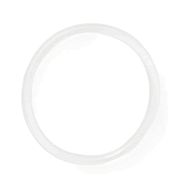Any form of birth control is better than no birth control when it comes to the environment. But let’s look a little closer at the claim that hormones in birth control are getting into the environment through pee. The simple answer is: yes, it is. But—and this is a big but—it is small compared to other sources of estrogen. Current research finds that the contribution of EE2 (the primary active ingredient in the pill, the ring, and the patch) to the total amount of estrogen in of our waterways is small. Bigger—much bigger—sources of estrogen in the environment come from industrial and manufacturing processes; agricultural fertilizers and pesticides; the drugs we give livestock; and the waste and runoff produced by these sources. Simply removing hormones from contraceptives will not eliminate the environmental impacts of estrogenic compounds. It’s much better to buy organic food if you can and even better to tell Congress to do its job and regulate chemicals, than to forego birth control. From Mother Earth’s standpoint, any form of birth control is better than no birth control.For purists who don’t want to add any hormones to the environment or to their body, no matter how small, there are options for you. Natural latex condoms and the copper IUD are two frequently cited examples of ultra-green contraceptives.
Birth control ring

I heard that hormone-filled pee is killing our fish and harming the environment. Is taking hormonal birth control bad for our water?
If I'm using another method of birth control, do I still have to use condoms?
It depends on your situation. Unless you’re in a totally exclusive relationship and you and your partner have both been tested recently for every single STI, using condoms with whatever other birth control method you choose is a good idea. Basically, if there’s any chance you or your partner could have an STI, the only way to decrease the risk of transmitting it is by using condoms, internal condoms, dental dams, and/or PrEP, (a medication which decreases the risk of getting HIV.) Other forms of birth control don’t protect against STIs.
Using a condom with another form of birth control is called dual protection. It means you’re being super-safe and protecting yourself against both pregnancy and STIs.
Does birth control work the minute I get it?
No, most forms of birth control are not effective immediately, so you want to check with you doctor before having unprotected sex. Until then, use a condom for added protection.
Can the ring get lost in my vagina?
No. The vagina is a closed pouch and doesn’t connect to the rest of the belly, so things (other than semen, bacteria, and other really, really, really small things) put in the vagina can’t travel to some other part of the body. There is no place for a tampon or a ring to go—they just sit right where you put them.
Want to learn more?
What's an ovarian cyst?
A cyst is basically a bubble—a collection of fluid with a thin wall around it. Functional cysts are formed when a follicle (the fluid-filled sac that develops around an egg during ovulation) grows larger than expected. Sometimes they can cause un-fun symptoms like abdominal discomfort, pelvic pain, pain during bowel movements, or pain during sex. Most cysts disappear on their own, but if they keep growing they can cause severe pelvic pain or pain that causes dizziness or fainting and comes with a fever or vomiting. If you have any of these severe symptoms, go see your health care provider ASAP. Some hormonal birth control methods—the ones that work by blocking ovulation—may mean fewer ovarian cysts. If you tend to get cysts, your provider might recommend you try a method like the pill, the ring, the patch, or the shot.
Are there benefits to birth control other than just controlling fertility?
There are a lot of great things about being on birth control that go beyond pregnancy prevention. Protection against ovarian cancer, an added boost to your vitamin D levels, lighter and less painful periods, the list goes on.
Want to learn more?
I’m a smoker. What birth control options are best for me?
For most people, the risk of blood clots when using the ring, the patch, or the combined birth control pill (which is the most common type of pill) is low. But smoking increases this risk. If you are over 35 and smoke 15 or more cigarettes a day, the combination pill, patch, and ring are not safe options for you. If you’re over 35 and you smoke less than 15 cigarettes a day, talk to your provider about whether these birth control methods are safe options for you. People who smoke can always use the IUD, the implant, the shot, the mini-pill (progestin-only pill), and any method that is hormone free (like condoms, for example).
The ring is too expensive. Any suggestions about how to get it for less?
Since we don’t exactly know what you’re paying now, we’ll cover a few scenarios to see if we can help you out:
If you’re on Medicaid, the ring might be free for you. If you have private insurance, it’s probably covered for no more than your copay.
If those aren’t options for you, check with the family planning clinics around you and find out if they offer free or low-cost birth control. Most do.
Another solution might be to ask your partner to help pay for the expense.
You could also check the NuvaRing or Annovera websites for discounts and coupons.
Want to learn more?
Does birth control cause depression?
The relationship between birth control and depression is complicated, especially since different methods can affect people very differently. If you feel your birth control might be contributing to depression, talk with your health care provider. Remember, there are a lot of birth control methods out there—don’t settle until you find the right one for you!
Want to learn more?
Does hormonal birth control cause depression?
It can be complicated to tell exactly how hormonal birth control affects mood, but you’re the only one who truly knows how you feel. Everyone reacts to birth control differently, so if you feel your birth control might be contributing to depression, talk with your health care provider. Remember, there are a lot of birth control methods out there—you can find the right one for you!
How much does the ring cost?
The ring costs between $15 and $50 per month, depending on your insurance situation, where you live, and where you get it.
If you’re on Medicaid, the ring might be free for you. If you have private insurance, it’s probably covered for no more than your copay.
Want to learn more?
What do I do if my ring is always slipping out?
There’s a chance you’re not inserting the ring correctly.
Try this: Use an empty tampon inserter to push it in all the way.
Want to learn more?

Heat up your weekends with our best sex tips and so much more.